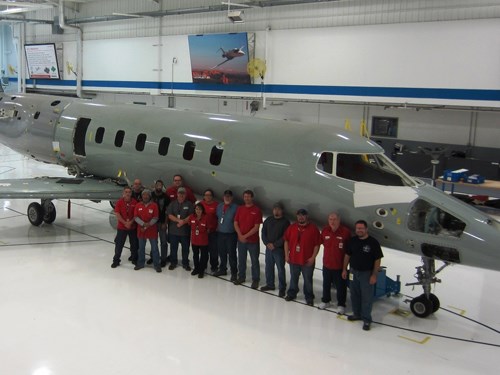Learjet 85 is tabled, but what of the technology that created it?
The Learjet 85 is has been put on hold by Bombardier, but a lot of effort went into the composites processes that helped create it. What will become of those?

Learjet 85 workers in Mexico had helped develop the out-of-autoclave processes used to fabricate the plane's fuselage.
Bombardier (Montreal, Quebec, Canada), disappointingly but not surprisingly, announced in mid-January that it is pausing the development of the composites-intensive Learjet 85 business jet and laying off 1,000 employees in Wichita, KS, US, and Querétaro, Mexico, who were working on the program. As a result, the company will record a pre-tax special charge in the fourth quarter of 2014 of approximately $1.4 billion, mainly related to the impairment of the Learjet 85 development costs. Bombardier pointed to the sluggish business jet market as the reason for the action.
“Bombardier constantly monitors its product strategy and development priorities,” says Pierre Beaudoin, president and CEO, Bombardier. “Given the weakness of the market, we made the difficult decision to pause the Learjet 85 program at this time. We will focus our resources on our two other clean-sheet aircraft programs under development, CSeries and Global 7000/8000, for which we see tremendous market potential. Both programs are progressing well.”
The question that remains is whether or not the Learjet 85 program has been simply paused, or whether it’s permanently discontinued. Official statements from Bombardier leave open the option of resurrecting the program. It’s possible, however, that the company is simply cutting its losses and moving on.
Whether or not the program survives, there’s no argument that Bombardier was unusually ambitious in the application of composites to the aircraft — particularly an aircraft of its relatively small size. Carbon fiber wingskins and spars for the plane were being fabricated in Belfast, Northern Ireland, using an in-autoclave resin transfer infusion process (RTI). More significantly, the fuselage was being infused out-of-autoclave (OOA) in Querétaro at an altitude of more than 6,000 ft. Fabricating a fuselage OOA is unusual by itself. Doing so at 6,000 ft, where available vacuum pressure is 20% less than at sea level, had tested Bombardier severely.
Still, when Bombardier’s Pierre Harter reported on the Learjet 85’s composites work at SAMPE 2013, it sounded like many of the technical hurdles has been cleared. Indeed, the process had been tuned to the point where Bombardier had void content of <1% in the fuselage structure. Such progress, it is hoped, can be applied elsewhere if it doesn’t live on in the Learjet 85.
Related Content
-
CompPair adds swift prepreg line to HealTech Standard product family
The HealTech Standard product family from CompPair has been expanded with the addition of CS02, a swift prepreg line.
-
VIDEO: One-Piece, OOA Infusion for Aerospace Composites
Tier-1 aerostructures manufacturer Spirit AeroSystems developed an out-of-autoclave (OOA), one-shot resin infusion process to reduce weight, labor and fasteners for a multi-spar aircraft torque box.
-
COMPINNOV TP2 project promotes use of thermoplastics in aerospace
Completed in 2023, COMPINNOV TP2 explored thermoplastic composites, enhancing the understanding between prepregs and production methods to foster the potential for French aerospace innovation.
















